A New Hope Awakens
The first weekend of Star Wars: The Force Awakens is behind us, and what a weekend it was. Multiple showings, late nights, box office records shattered, and a resoundingly positive cheer from critics and from fans new and old. While superlatives and hater backlash are inevitable byproducts of a successful franchise installment, The Force Awakens (I will simply refer to the movie as TFA for the duration of the article) largely has the US and global audiences buzzing with adventure, excitement—things Jedi’s do not crave—and a gnawing hunger for Episode VIII to come out right now.
There are so many exciting questions, opinions, tidbits, and moments, and new fan theories from TFA that deserve time, energy, and articles. However, the biggest meta-reality of the new movie, and also the loudest criticism I am hearing, is the similarities between TFA and George Lucas’ original film, Star Wars: Episode IV – A New Hope. The criticism docks the movie for being too much like the original and essentially treading little to no new ground. As a consequence, there are few surprises and little that feels original or interesting. One commentator went as far to call TFA’s “beat-for-beat remake” an exercise in “decadence” and repetition. For some reason, he also thinks it necessary to take a swipe at critics who are lauding the movie.
 While I definitely respect and value some of these critics opinions more than my own, I still think they are largely misguided or partially informed criticisms. J.J. Abrams and Kathleen Kennedy stated what their principle starting point and goal is what audiences would feel when they saw TFA. They wanted it to feel like Star Wars and they succeeded. The new movie is respectfully nostalgic while also telling the same story in a new and interesting way. As Mark Hamill said in the Comic-Con behind the scenes trailer, “Everything has changed but nothing has changed.”
While I definitely respect and value some of these critics opinions more than my own, I still think they are largely misguided or partially informed criticisms. J.J. Abrams and Kathleen Kennedy stated what their principle starting point and goal is what audiences would feel when they saw TFA. They wanted it to feel like Star Wars and they succeeded. The new movie is respectfully nostalgic while also telling the same story in a new and interesting way. As Mark Hamill said in the Comic-Con behind the scenes trailer, “Everything has changed but nothing has changed.”
Leveling your sights at Abrams’ use of the original story in order to criticize the film is as misguided as criticizing movie adaptations of Charles Dickens’ A Christmas Carol as “beat-for-beat remake[s]” and lacking surprise. I can’t imagine critics of using the same story elements from A New Hope are unfamiliar with Star Wars monolithic influence and significance to multiple generations of people around the world.
When George Lucas first released the original film in 1977, he tapped into the research and mind of Joseph Campbell and drew on the hero’s journey to tap into what makes a good story. Since then, Star Wars has been a seminal work for filmmakers, authors, screenwriters, and storytellers when both teaching about narrative and developing their own stories. To return to my analogy, Star Wars, from a cultural standpoint is just as significant of a story as the classic Dickens novel, A Christmas Carol. They both mine deeply from the anthropology of myth, the inherent spirituality of humanity, and the significance of community in stories and in telling stories.
The power of myth and significance of culture’s collective stories is the ability to mold and shape stories to fit current, significant cultural shifts and tell familiar stories to fit new generations. It is both the benefit of the Bible, which tells stories and one big story that is communicable across all cultures, but also its challenge. Scholars, pastors, and teachers seek to avoid destroying the core of what the Bible says while being cognizant enough to know when the culture has negatively affected the Bible’s message.
To pick something outside of the Bible, think of how Greeks and Romans viewed their own deities. Roman gods were essentially co-opted Greek gods with new names and slightly different stories. They were significant stories in developing a collective cultural identity and morality, but names changed and some story elements changed. No one called out the Romans and took them to task for making these changes, but it was recognizing the significance of Greek culture on their own culture while also developing new and slightly different stories to build their own distinct cultural heritage, social mores, and religious devotion.
The same is true, but not of eternal or religious significance when it comes to our culture’s stories. Our stories exist not to be immovable monoliths or artifacts we can return to and analyze, but in the spirit of Lucas’ take on myth and story, they exist to change as we collectively change. Abrams’ and the story group kept the spirit of Star Wars alive by taking the same story and giving us two significant and many more minor changes to that story.
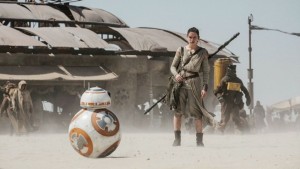 First off, we have the familiar archetype of the hero’s journey. Someone who is orphaned, literally nothing, and is even described as “no one”. But, in a significant and much-needed change, gone is the farm boy of the original story and he is replaced by a young, self-reliant, tough young girl. Rey, played brilliantly and to near-perfection by Daisy Ridley, is Luke Skywalker, right down to the dusty, desert planet she calls home. She is a lowly scavenger, a backwater hick, who has a secret past and power, turns down the initial call, but then eventually embraces her destiny and wins the day. She is that same character, but she is wholly different.
First off, we have the familiar archetype of the hero’s journey. Someone who is orphaned, literally nothing, and is even described as “no one”. But, in a significant and much-needed change, gone is the farm boy of the original story and he is replaced by a young, self-reliant, tough young girl. Rey, played brilliantly and to near-perfection by Daisy Ridley, is Luke Skywalker, right down to the dusty, desert planet she calls home. She is a lowly scavenger, a backwater hick, who has a secret past and power, turns down the initial call, but then eventually embraces her destiny and wins the day. She is that same character, but she is wholly different.
It cannot be stressed enough how significant it is that Rey is a woman. This is the most recognizable movie franchise in history, and it is now being helmed by Daisy Ridley. And not only is the choice significant but, as I said before, Ridley knocks it out of the park. She’s charming, she’s fun, she’s a tad naive, but she is also loyal, committed, and resilient. Ridley infects the right amount of everyman, innocence, and enviable character traits to pull off something that could hardly be conceived; a believable heir to Mark Hamill’s throne as the hero of a galaxy far, far away.
The other significant change and my favorite character of TFA is the wrinkle of a menacing, yet unstable villain; Kylo Ren. He’s everything we should have gotten in a prequel Vader trilogy instead of politics and Jar Jar. Like Vader from the original trilogy, he is a villain on a mission to eliminate opposition, and he flexes his Force muscles with a super cool moment in the beginning by freezing Poe’s laser bolt in its place. He then shows his inner-Vader by ordering the execution of an entire village. There is no question Ren means business and he is not a nice or compassionate dude.
When it is finally revealed just how far he has come—proclaiming his past as Ben Solo, son of Han and Leia, to mean nothing to him—he is quickly revealed to have more Vader in him than the evil his father and mother saw in him. He is highly volatile, out-of-control, and lacking discipline. When things don’t go his way, he activates his lightsaber and destroys whatever is in sight. Rey’s vocalizing of his fear he will never measure up to Vader, his grandfather, is a meta hat-tip to both Driver’s characterization of the new villain and Ren’s own inability to be as menacing or as controlled as the now deceased Dark Lord of the Sith.
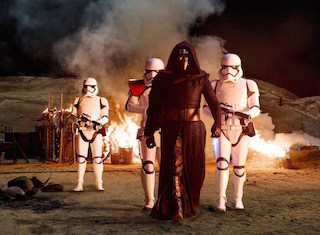 However, he is more like Vader than he realizes. Anakin, whining and Hayden Christensen aside, was just as unstable and unsure as Kylo Ren. They both embrace the Dark Side to avoid losing something; Anakin doesn’t want to lose Padme and Ren does not want to lose his power or his position with Snoke. In fact, an interesting side point is how General Hux and Kylo Ren are jockeying for position with Snoke. When things don’t go right for Ren, in steps Hux to hatch his plan. When Hux’s plan fails, Snoke tells him to bring Ren to complete his training. Gone are the self-assured, martial clip of the Imperials. Now, the First Order is a shadow of what the Empire once was and the bad guys are out to prove themselves just as much as the good guys are.
However, he is more like Vader than he realizes. Anakin, whining and Hayden Christensen aside, was just as unstable and unsure as Kylo Ren. They both embrace the Dark Side to avoid losing something; Anakin doesn’t want to lose Padme and Ren does not want to lose his power or his position with Snoke. In fact, an interesting side point is how General Hux and Kylo Ren are jockeying for position with Snoke. When things don’t go right for Ren, in steps Hux to hatch his plan. When Hux’s plan fails, Snoke tells him to bring Ren to complete his training. Gone are the self-assured, martial clip of the Imperials. Now, the First Order is a shadow of what the Empire once was and the bad guys are out to prove themselves just as much as the good guys are.
The similarities are obvious, and the differences are, as well. But don’t miss that Abrams is still communicating “out with the old, in with the new”. The biggest revelation and spoiler of TFA is the death of Han Solo. Mirrored by that of Obi-Wan’s death in A New Hope, Han’s death is a clear signal the movies going forward from here will look radically different. Heck, Gareth Edwards has said there will be no Jedi and no Force in Rogue One!
The Force Awakens is connective tissue that binds what once was and now what is. It builds on the old foundation, harkens back to what has made us kids, and eased the transition from the old to the new. At the least, it is a retelling of a cultural significant story we all love. At best, it is our first steps into a larger, cinematic world. For me, it is an awakening to a new hope of culturally significant Star Wars stories.
Can it be next Christmas, yet?


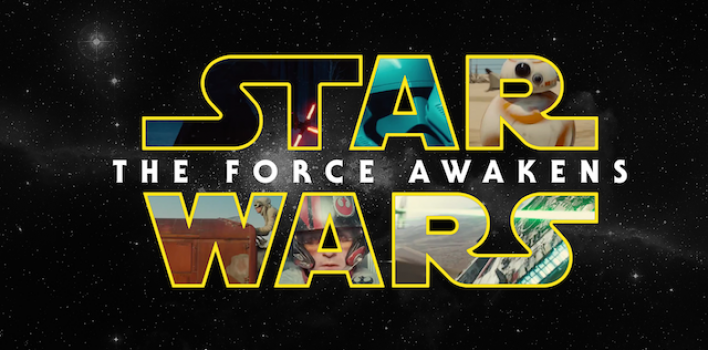
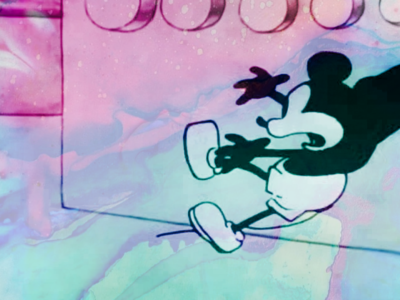
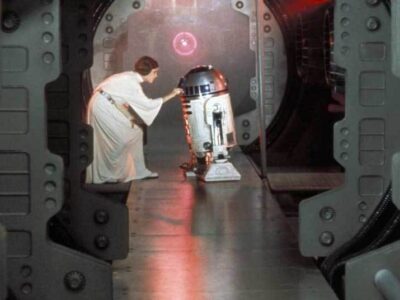
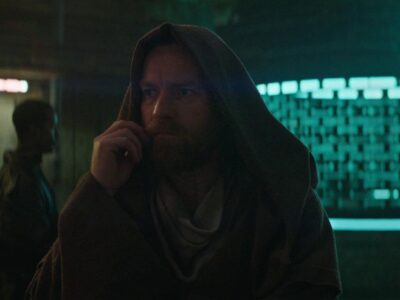


Pingback: #086 – CROSSOVER: Star Wars When Faith Awakens | Reel World Theology
Pingback: Review| Star Wars: The Force Awakens | Reel World Theology
Thanks for the review. You really know how to breakdown a movie. Seeking to understand this longing and call of the hero’s journey as I explain to teens the inner calling to be a man and how Jesus was the man we were created to be.
Just saw this comment now. Thanks for reading, Luke! We’re out to do just that among all of us here and we hope our articles and reviews are doing just that.